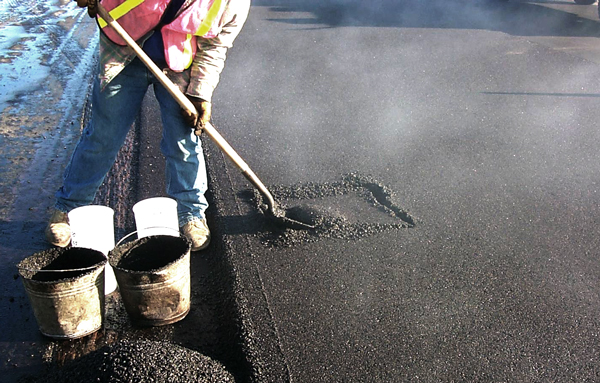Hot Mix Asphalt: The Foundation for Safe and Secure Angled Parking Lots
Hot Mix Asphalt: The Foundation for Safe and Secure Angled Parking Lots
Blog Article
Unlocking the Keys of Warm Mix Asphalt Modern Technology
Discovering the depths of warm mix asphalt innovation uncovers a globe where careful procedures and precise solutions converge to shape our roads and infrastructure. The blend of accumulations, fillers, and binders isn't merely a building and construction task yet a calculated orchestration of longevity and effectiveness. As we peer right into the detailed dancing of elements, a tapestry of resilience and sustainability unravels. What exists beneath this surface of asphaltic mastery, and what tricks wait to be introduced in the world of leading advancements?
Relevance of Hot Mix Asphalt
Hot Mix Asphalt plays a critical function in modern-day framework development due to its toughness and cost-effectiveness. As the most generally used leading material for roads, highways, and car parking whole lots, Warm Mix Asphalt supplies a range of advantages that contribute to its relevance in building projects.
The longevity of Hot Mix Asphalt comes from its composition, that includes aggregates, binder, and filler products that are carefully selected and blended to meet specific efficiency demands. This specific combination leads to a solid and adaptable sidewalk that can withstand regular use without significant damage. Moreover, Warm Mix Asphalt is 100% recyclable, more enhancing its sustainability and ecological benefits. In general, the importance of Hot Mix Asphalt in infrastructure development can not be understated, as it continues to be a keystone of modern construction methods.
Parts of Asphalt Mixes
The structure of asphalt mixes is composed of very carefully chosen aggregates, binder, and filler materials that are crucial for achieving particular performance requirements. Aggregates are the primary element of asphalt mixes, offering strength and security. The binder, usually asphalt or asphalt cement, holds the accumulations together and gives adaptability and sturdiness to the mix.
The combination and proportion of these parts play a significant duty in determining the quality and performance of the asphalt mix. Designers carefully design the mix to meet certain demands, considering variables like traffic volume, climate conditions, and pavement life-span. Correct option and harmonizing of aggregates, binder, and fillers are vital for creating durable, resilient asphalt pavements.
Combining and Manufacturing Techniques

When the aggregates are selected, the binder, usually asphalt concrete, is contributed to bind the materials together. The binder's quality and quantity substantially influence the mix's adaptability, strength, and resistance to ecological elements. Additionally, fillers like hydrated lime or Portland concrete might be integrated to improve certain attributes of the asphalt mix, such as its workability or moisture resistance.
During manufacturing, the aggregates and binder are heated up, commonly in between 250-325 ° F(121-163 ° C ), Extra resources to facilitate blending and guarantee correct layer of the aggregates. The mixing process has to be extensive to attain an uniform mix that promotes the preferred imp source efficiency characteristics of the asphalt. Various methods, such as set blending or drum mixing, are used to attain top quality and regular asphalt mixes for building tasks.
Elements Influencing Asphalt Efficiency
Aspects influencing asphalt performance encompass a range of variables that influence the durability, long life, and total top quality of asphalt pavements. One crucial element is the top quality of materials utilized in the asphalt mix.

Ecological problems additionally affect asphalt efficiency. Temperature variations, wetness infiltration, and website traffic loads can all affect the structural stability of the pavement. Design considerations, such as sidewalk density and water drainage, are necessary in ensuring the lasting performance of the asphalt pavement. By very carefully taking into consideration these specialists, designers and elements can maximize asphalt efficiency and enhance the life span of sidewalks.
Sustainable Practices in Asphalt Modern Technology

In addition, the development of warm-mix asphalt (WMA) innovations has actually obtained grip in recent times. WMA enables the production and placement of asphalt mixes at reduced temperatures compared to typical hot-mix asphalt, resulting in reduced power intake and greenhouse gas discharges. The usage of porous asphalt blends can help alleviate stormwater runoff issues by allowing water to penetrate via the pavement and into the ground, promoting all-natural water filtering and reenergize processes. By implementing these lasting practices, the asphalt industry can contribute to building an extra resistant and environmentally friendly facilities network.
Conclusion
In final thought, warm mix asphalt innovation plays an essential function in contemporary framework growth due to its toughness and cost-effectiveness. By carefully balancing parts, utilizing proper blending techniques, and considering numerous elements, engineers can produce top quality asphalt blends that stand up to heavy web traffic loads and rough weather. Embracing sustainable techniques, such as visit site using warm-mix technologies and recycled products, further improves the ecological friendliness of asphalt innovation.
Blending and production methods in hot mix asphalt modern technology involve the accurate combination and handling of accumulations, binder, and fillers to create a long lasting and high-performance asphalt mix.Factors influencing asphalt performance encompass a range of variables that impact the durability, longevity, and overall top quality of asphalt sidewalks. Lasting methods in asphalt modern technology incorporate numerous initiatives intended at lowering the ecological effect of asphalt production and paving processes. By incorporating redeemed asphalt pavement (RAP) and recycled asphalt shingles (RAS) into brand-new asphalt mixes, the market can significantly lower the intake of raw products and energy, while also lowering land fill waste.
WMA allows for the manufacturing and placement of asphalt blends at lower temperature levels compared to traditional hot-mix asphalt, resulting in minimized energy intake and greenhouse gas emissions.
Report this page